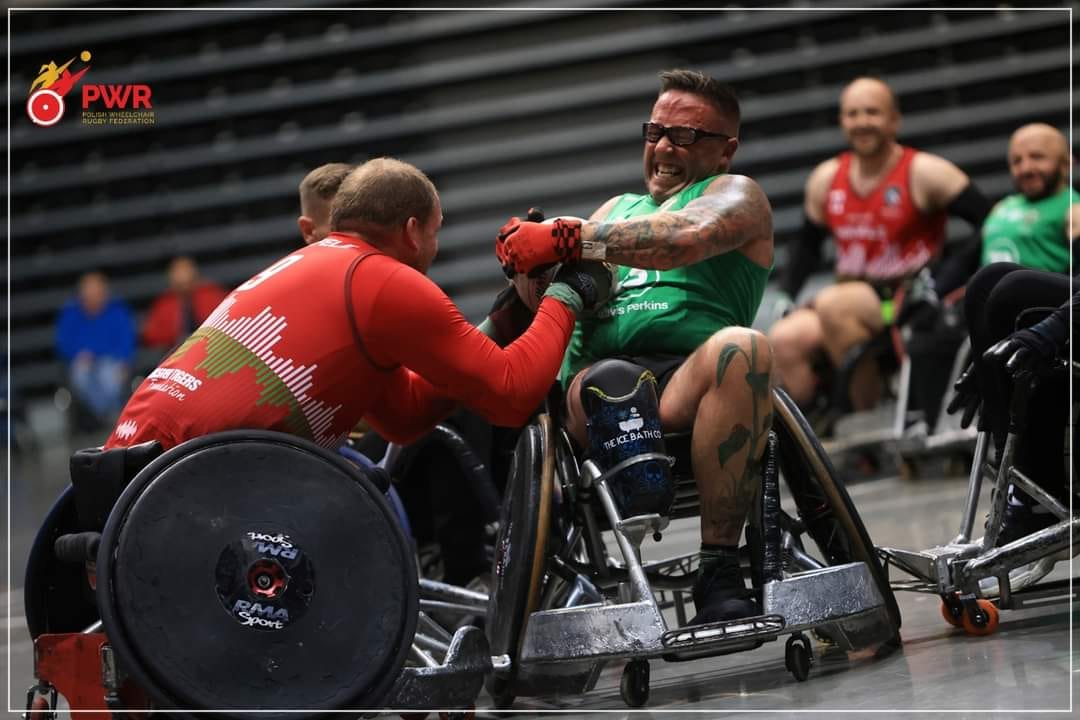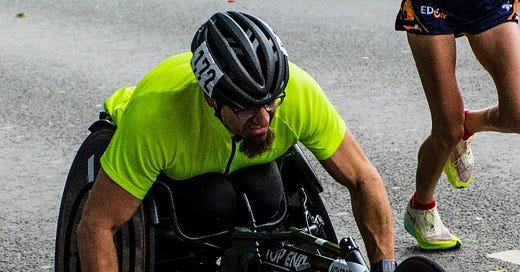Steve Montgomery on the do's and don'ts of how to treat wheelchair racers
Wheelchair athlete Steve Montgomery has competed as an elite athlete in the London Marathon, but that didn't stop one runner giving him a 'push start'
It’s free to read all our articles on Running Tales - we believe it’s important for our stories to reach, and inspire, the most people possible. But that doesn’t mean we don’t need support, and (frankly) money, to continue the work we do.
We therefore appreciate all our paid subscribers, who can take advantage of a discount on our merchandise as well as the ‘warm, fuzzy feeling’ supporting this newsletter will hopefully give them.
Throughout September, we will be offering new paid subscribers a 20% discount, for life! To take advantage of this offer simply click the link below and following the instructions there. Thank you.
Steve Montgomery said the biggest shock he ever had as a wheelchair athlete was when a runner took it upon themselves to give him a push start.
He understatedly calls the move a ‘little bit outrageous”.
The incident is one of the first that comes to mind when Steve is asked about the lessons some runners could learn when interacting with wheelchair racer.
Steve, who admits he wasn’t an athletic person for most of his life, found sport when he went along to a wheelchair rugby session. It was the start of a journey which saw him go on to become a member of the WR5s Premiership title winning Northampton Saints wheelchair rugby side.
His move into wheelchair racing came later but he has since reached the elite level competing in the London Marathon and other high profile events.
Running Tales asked Steve to give us his dos and don’ts for runners and others when engaging with wheelchair racers:
Do: Be welcoming
Steve said the number one thing able-bodied runners - and those taking part in sport generally - can do for wheelchair athletes is to make them welcome.
He told Running Tales it is important for wheelchair users to embrace the opportunities that are out there.
“The two sports I do, racing and wheelchair rugby, I never thought - going back ago - that I would enjoy them as much as I do,” he said.
“It’s really good to try and seek out taster sessions. At most of the sessions I have been to, including other things that I have tried, people have been so friendly.
“It’s such a nice environment - hunt these things down and have a go.”

Steve’s fellow Northampton Saints star, Gerry McCrory, agrees.
Gerry, an amputee who has a prosthetic leg, can walk normally in every day life, but plays rugby in a wheelchair.
He said wheelchair athletes “will generally just crack on with what they need to do.
“It’s more for the able-bodied people. They are like, ‘do I help or do I not help, what do I do and what do I not do’?”
“Just treat us as normal,” Steve said. “We are nothing special. We just want to enjoy the race the same as everybody else and be welcomed.”
Don’t: Help when it’s not wanted
Many wheelchair racers have horror stories about how they’ve suddenly found themselves grabbed from behind and pushed along during races or at parkrun.
Such incidents - however well meaning those doing the pushing might be - can be extremely unsettling, as well as insulting for people trying to achieve their own personal goals.
It is always best to ask wheelchair athletes if they need help or not.
For Steve, who has a parkrun personal best of 17.04, it is not such a problem but that hasn’t stopped other runners interfering with his race.
“I’ve not had the chair grab,” he said. “But I did have somebody use me to give them a push start at the start, which was a little bit outrageous.”
Do: Be accommodating
Steve said he has had an overwhelmingly positive reaction from race/run directors, but some smaller events can struggle to know what to do when presented with a wheelchair athlete.
“Generally I’ve not had any issues, particularly with the bigger events. With things like the London Marathon, it’s been really, really easy,” he told Running Tales.
“For some smaller sporting events - some of the local races - there is a little bit of resistance where race directors are not used to wheelchair racers and so there is hesitation.
“But generally most race directors accommodate me and will make a very minor change to a course or to the event.”
He said his local parkrun in Northampton is “a really good example” of a run which has accommodated wheelchair users.
“When I first started at the parkrun, I started at the same time as all the other runners and would get snarled up with them.
“Even though I was a little bit quicker than them overall, initially they would have the advantage over me from the start line.
“Just a very subtle change, to give me a 30 second head start, made all the difference.”
Steve said a “very small briefing” at the start of events is usually enough to let people know he is competing and advise runners to keep to one side if possible so wheelchair racers can get by easily if they need to.
Thanks for reading and listening to Running Tales. We couldn’t do this without your support - please back us to keep going by…
This article was first published as part of a longer piece on ‘The do's and don'ts of how to treat disabled runners’





